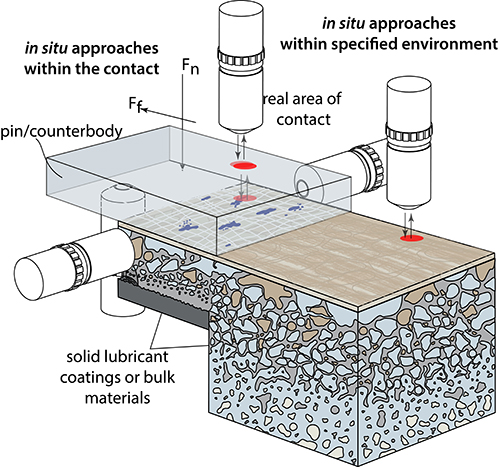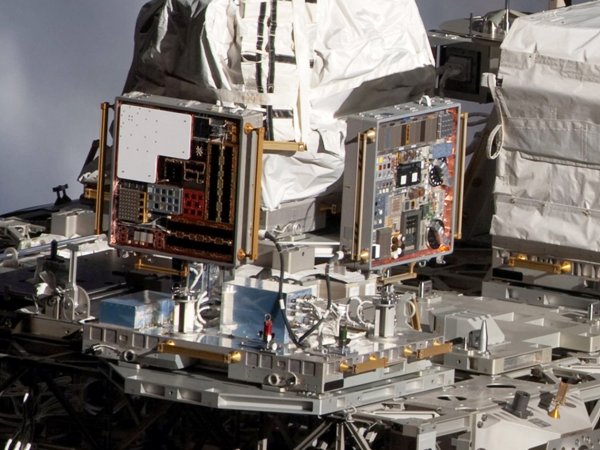Lehigh University
The Tribology Laboratory at Lehigh University
Research
Material Systems
Polymers, Polymer Composites and Polymer Nanocomposites for Tribological Applications
One material studied in the Tribology Laboratory is ultra-low-wear, low-friction hierarchical and multifunctional nanocomposites based on PTFE (Teflon®; lowest friction coefficient of any bulk polymer) that reduce its wear by more than 10,000 times with the inclusion of a few volume percent filler.
Polytetrafluoroethylene is a unique and fascinating material that has been closely studied by researchers since its accidental discovery in 1938 [9-30] . It is chemically inert, vacuum compatible, stable at high temperatures and has a low friction coefficient [9, 10, 12, 14, 15] . PTFE consists of a fully fluorinated single bonded carbon backbone (Fig. 2-1). The C-F bonds are very strong and serve to protect the polymer from chemical attack. The molecular weight of PTFE can be more than 30,000,000. The structure of PTFE leads to its numerous advantages and disadvantages.
Polytetrafluoroethylene as a Tribological Material
In the early 1940s, PTFE was reported as having a friction coefficient of 0.1, the lowest friction coefficient of any bulk polymer [10]. In the 1950s, this extremely low friction, in combination with PTFE’s other promising properties, prompted a spark of interest among many researchers in the tribology and polymer communities [11-14, 31-33] . In these studies, friction coefficients were reported between .04 and 0.4. It was hypothesized that PTFE makes a thin, molecularly aligned transfer film on the counter surface that it slides against [34]. As a result, the relative sliding occurs at an interface between PTFE and the PTFE transfer film, which produces a low, consistent friction coefficient for PTFE when paired with a large variety of countersurface materials. Pooley and Tabor found that the friction coefficient of PTFE was low when sliding in the direction of the oriented PTFE molecules, however, increased significantly when sliding perpendicular to the molecular orientation [16, 35]. From this observation they concluded that the low friction in PTFE is caused by fully fluorine encased rigid chains sliding over one another.
PTFE does suffer from one major downfall: a high wear rate averaging around much as 1x10-4 to 1x10-3 mm3/Nm under common engineering sliding conditions [17, 34, 36] . This high wear rate limits the use of PTFE as a bulk solid lubricant. The high wear rate and the wear mechanisms of PTFE also leads to large, flakey wear debris, which can also be very disadvantageous.
Low wear rates have been observed in PTFE at low contact pressures and sliding speeds [17, 34]. However, under typical engineering sliding speeds and loads, wear rates are often very high at as much as 1x10-3 mm3/Nm. Tanaka mapped out the wear of PTFE as a function of temperature and sliding speed. This transition in wear rate suggests a threshold between multiple wear mechanisms. Tanaka proposed that the banded structure [14, 15] of PTFE is responsible for this large scale, flakey wear debris and compared it to a deck of cards. At lower sliding speeds and contact pressures, the wear of PTFE is extremely low.
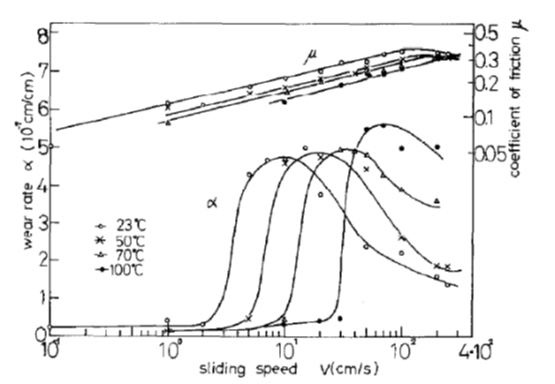
“Variations of wear rate and coefficient of friction with speed at temperatures below 100ºC” as reported by Tanaka [17] . Reprinted from K. Tanaka, Y. Uchiyama, S. Toyooka, Mechanism of wear of polytetrafluoroethylene, Wear 23 (1973) 153-172. Elsevier Limited, Oxford.
Studies by Blanchet and Kennedy suggest a different source of the flakey wear debris. They suggest that at higher sliding speeds, a delamination wear is initiated due to the kinetic friction coefficient reaching a threshold [20]. At this threshold, subsurface shearing of the polymer becomes preferential as the shear stress at the internal interfaces of the PTFE become lower than the shear stress at the interface. This promotes subsurface crack propagation, joining, and delamination wear [37].
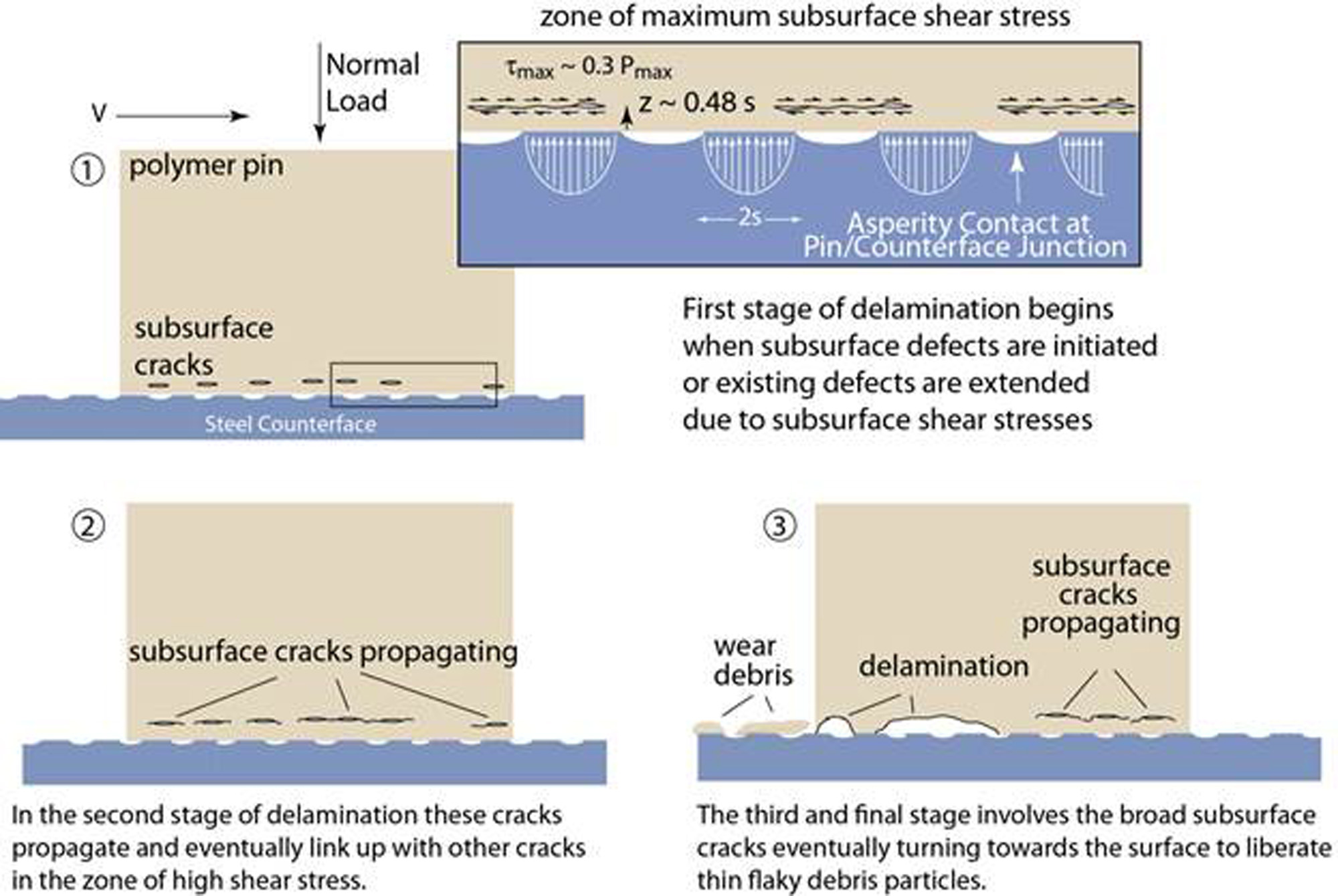
Subsurface crack propagation and delamination wear in PTFE as described by Blanchet and Kennedy [20]
Polytetrafluoroethylene Composites
PTFE is used as both a matrix and filler in composites for tribological applications [17, 19-23, 25-28, 36, 38-63] (Figure 2-4). Both PTFE filled composites and PTFE matrix composites have extreme success stories with wear rates less than 1x10-7mm3/Nm [27, 28, 56, 61] (approximately three to four orders of magnitude less than bulk PTFE). As a filler, PTFE’s primary purpose is to reduce friction, although it does have the effect of reducing wear [28]. In contrast, when fillers are added to PTFE as a matrix to reduce the wear, there is often an increase in friction coefficient [61].
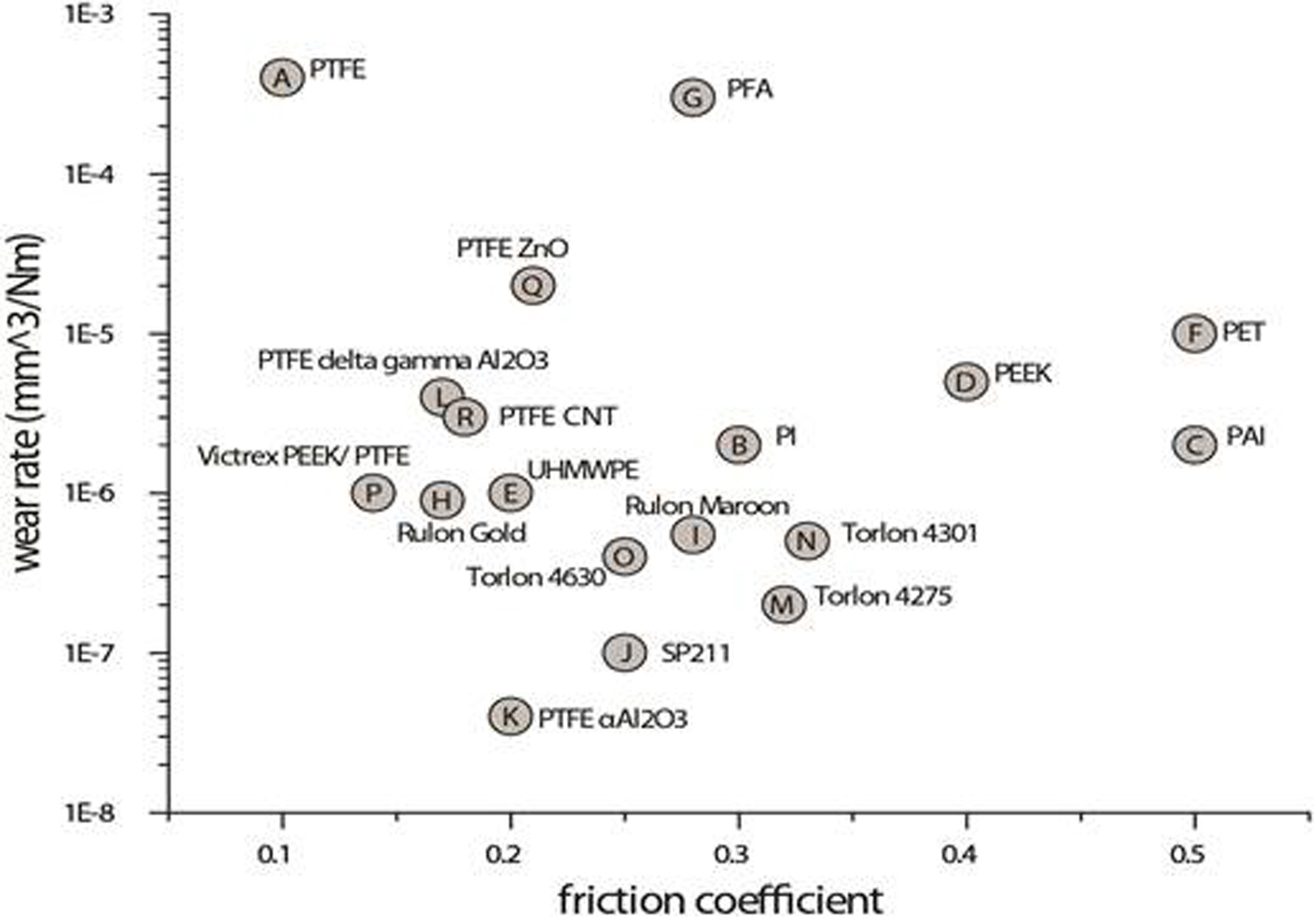
Wear rate vs. friction coefficient for tribological composites of PTFE and a several other tribological engineering polymers from several sources. A – PTFE2, B – PI [64] , C – PAI [64] , D – PEEK [64] , E – UHMWPE [64] , F – PET [64] , G – PFA , H – Rulon Gold1, I – Rulon Maroon2, J – SP2112 , K – PTFE αAl2O31, L – PTFE DGAl2O31, M – Torlon 4275 , N – Torlon 43013, O – Torlon 46302, P – Victrex PEEK/PTFE1, Q – PTFE ZnO [23] , R – PTFE carbon nanotube [52]
Conventional Filled Polytetrafluoroethylene Composites
Almost everything imaginable has been included as a filler material in PTFE. Most fillers serve to reduce wear while increasing friction. Fillers serve to reduce the wear by typically one or two orders of magnitude. Several hypothesis exist as to why fillers serve to reduce the wear of PTFE [18, 20, 23, 25, 38-41, 52, 61, 65-67] . Preferential load support [39, 68] and arresting crack propagation [20, 66] are among the two most popular theories. Fillers arrest subsurface cracks and prevent the PTFE from delaminating at the surface.
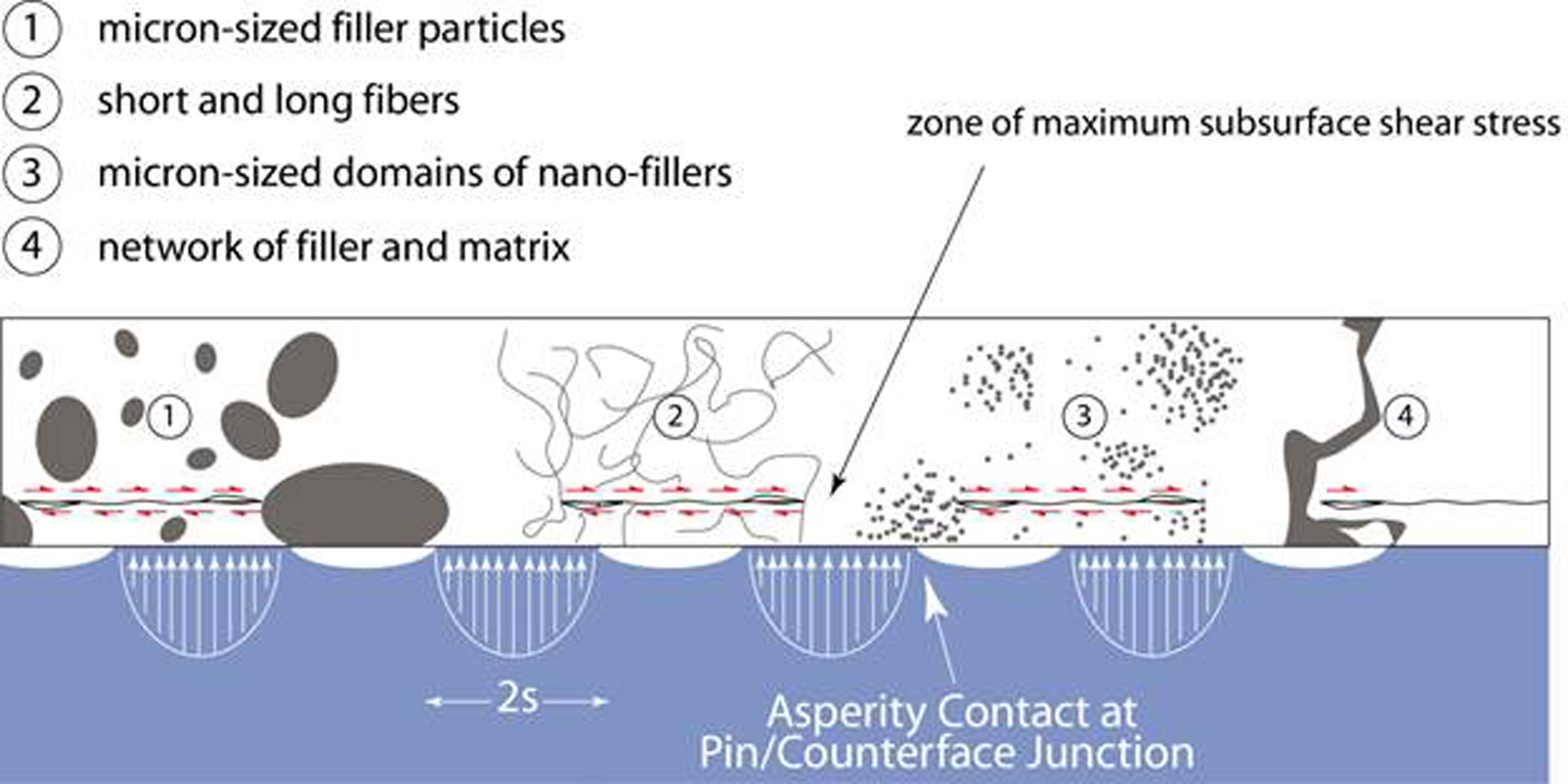
Shutting down the subsurface crack propagation and delamination wear mechanism in PTFE. Cracks are arrested by various filler sizes and geometries including 1) microparticles, 2) fibers, 3) nanoparticles and 4) Composite networks of filler and PTFE matrix.
Traditionally, hard micro-and nano-particles and fibers/networks of glass, polymers and other materials and metals are used as fillers in PTFE. Blanchet and Kennedy proposed that fillers serve to shut down the delamination wear of PTFE [45]. Through experiments with high density and low density poly ethylene, Briscoe proposed that fillers promote the generation of thin, well adhered transfer films that reduce wear by slowing the removal and subsequent replacement of transfer films [38].
With these filled PTFE composites, the wear rates can be commonly reduced to around 1x10-5 mm3/Nm (and as low as 1x10-6 mm3/Nm). In systems where the wear rate is close to the wear rate of PTFE at slow sliding conditions, the primary function of the filler is to provide load support [39] and arrest subsurface cracks and halt delamination wear [45]. As filler volume concentrations increase, it is possible that the sliding is no longer occurring between the PTFE and the countersample, but is occurring between the filler and the countersample, the filler and the tribofilm, the sample and the tribofilm, the sample and the filler or some dynamic combination of these possible material interactions.
For nanoparticle filled systems that produce low wear at low filler percent, Li et al. agreed with the theory of Briscoe that thin, robust, well-adhered transfer films bond to the counter sample and protect the sample from further wear [23, 38] . Others suggested that nanoparticles prevent the crystalline structure of the PTFE from being destroyed during sliding [52]. Tanaka, however, found that nanoparticles that are too small are no longer able to adequately prevent the large scale destruction of the banded structure of PTFE to successfully slow down the wear of PTFE [39].
Many PTFE composites show some appreciable run-in behavior in which the initial wear rate is higher than that of the steady state wear rate. This run-in suggests there is an initial transient process occurring that leads to lower wear systems. It could be that enough of the polymer must be worn away to generate some critical amount of filler at the surface. It could also be the formation of a well adhered, protective transfer film that the polymer slides over the transfer film.
Ultra-Low Wear Polytetrafluoroethylene and α Al2O3 Nanocomposites
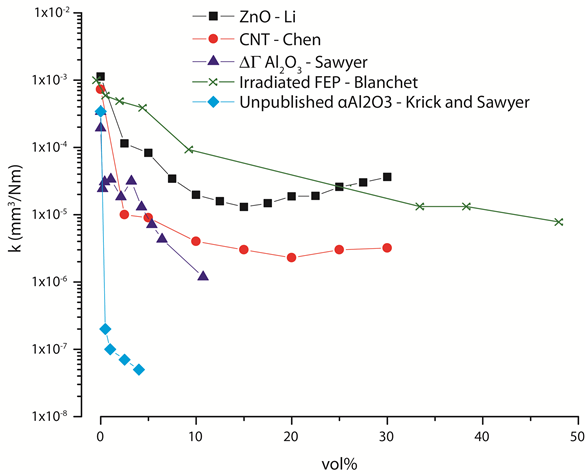
Wear rate vs. filler volume percent for PTFE matrix composites. The fillers include ZnO [23], carbon nanotubes (CNT) [52], DG Al2O3 [25], and irradiated FEP [47].
Some filler materials provide a remarkable reduction in wear (over 1000x increase in wear resistance) at very low volume percent (less than 2). Alpha phased alumina is one of those fillers. At low loading fractions it is better than some of the other composites by several orders of magnitude. These materials rely on new mechanisms for their ultra-low wear performance. Through environmental studies, we showed that there is a tribochemical mechanism responsible for this ultralow-wear behavior.
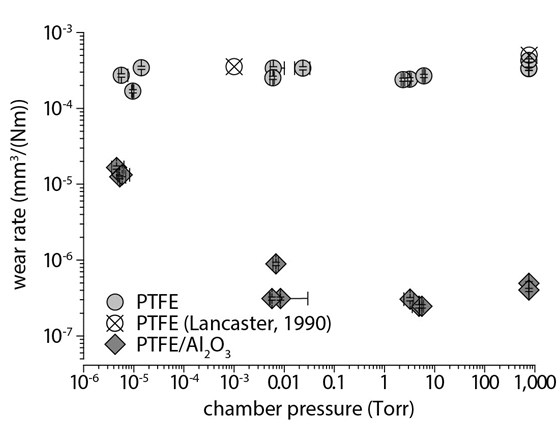
1. Archard, J.F., Contact and rubbing of flat surfaces. Journal of Applied Physics, 1953. 24(8): p. 981-988.
2. Archard, J.F., Single contacts and multiple encounters. Journal of Applied Physics, 1961. 32(8): p. 1420-&.
3. Holm, R. and E. Holm, Electric contacts handbook. 1958, Berlin: Springer.
4. Stachowiak, G.W. and A.W. Batchelor, Engineering tribology. 2005, Oxford: Elsevier.
5. Williams, J.A., Engineering tribology. 1994, Oxford: Oxford University Press, Inc.
6. Schmitz, T.L., et al., The difficulty of measuring low friction: Uncertainty analysis for friction coefficient measurements. Journal of Tribology-Transactions of the Asme, 2005. 127(3): p. 673-678.
7. Burris, D.L. and W.G. Sawyer, Measurement uncertainties in wear rates. Tribology Letters, 2009. 36(1): p. 81-87.
8. Colbert, R.S. and W.G. Sawyer, Thermal dependence of the wear of molybdenum disulphide coatings. Wear, 2010. 269(11-12): p. 719-723.
9. Hanford, W.E. and R.M. Joyce, Polytetrafluoroethylene. Journal of the American Chemical Society, 1946. 68(10): p. 2082-2085.
10. Renfrew, M.M. and E.E. Lewis, Polytetrafluoroethylene - heat-resistant, chemically inert plastic. Industrial and Engineering Chemistry, 1946. 38(9): p. 870-877.
11. Shooter, K.V. and D. Tabor, The frictional properties of plastics. Proceedings of the Physical Society. Section B, 1952. 65(9): p. 661.
12. Bunn, C.W. and E.R. Howells, Structures of molecules and crystals of fluorocarbons. Nature, 1954. 174(4429): p. 549-551.
13. Flom, D.G. and N.T. Porile, Friction of teflon sliding on teflon. Journal of Applied Physics, 1955. 26(9): p. 1088-1092.
14. Bunn, C.W., A.J. Cobbold, and R.P. Palmer, The fine structure of polytetrafluoroethylene. Journal of polymer science, 1958. 28(117): p. 365-376.
15. Speerschneider, C.J. and C. Li, Some observations on structure of polytetrafluoroethylene. Journal of Applied Physics, 1962. 33(5): p. 1871-&.
16. Pooley, C.M. and D. Tabor, Transfer of PTFE and related polymers in a sliding experiment. Nature-Physical Science, 1972. 237(75): p. 88-&.
17. Tanaka, K., Y. Uchiyama, and S. Toyooka, Mechanism of wear of polytetrafluoroethylene. Wear, 1973. 23(2): p. 153-172.
18. Uchiyama, Y. and K. Tanaka, Wear laws for polytetrafluoroethylene. Wear, 1980. 58(2): p. 223-235.
19. Gong, D.L., Q.J. Xue, and H.L. Wang, ESCA study on tribochemical characteristics of filled PTFE. Wear, 1991. 148(1): p. 161-169.
20. Blanchet, T.A. and F.E. Kennedy, Sliding wear mechanism of polytetrafluoroethylene (PTFE) and PTFE composites. Wear, 1992. 153(1): p. 229-243.
21. Blanchet, T.A. and Y.L. Peng, Wear-resistant polytetrafluoroethylene via electron irradiation. Lubrication Engineering, 1996. 52(6): p. 489-495.
22. Zhang, Z.Z., et al., Friction and wear characteristics of metal sulfides and graphite-filled PTFE composites under dry and oil-lubricated conditions. Journal of Applied Polymer Science, 1999. 72(6): p. 751-761.
23. Li, F., et al., The friction and wear characteristics of nanometer ZnO filled polytetrafluoroethylene. Wear, 2001. 249(10-11): p. 877-882.
24. Briscoe, B.J., H. Mahgerefteh, and S. Suga, The effect of gamma irradiation on the pressure dependence of the room temperature transition in PTFE. POLYMER, 2003. 44(3): p. 783-791.
25. Sawyer, W.G., et al., A study on the friction and wear behavior of PTFE filled with alumina nanoparticles. Wear, 2003. 254(5-6): p. 573-580.
26. McCook, N.L., et al., Wear resistant solid lubricant coating made from PTFE and epoxy. Tribology Letters, 2005. 18(1): p. 119-124.
27. Burris, D.L. and W.G. Sawyer, Improved wear resistance in alumina-PTFE nanocomposites with irregular shaped nanoparticles. Wear, 2006. 260(7-8): p. 915-918.
28. Burris, D.L. and W.G. Sawyer, A low friction and ultra low wear rate PEEK/PTFE composite. Wear, 2006. 261(3-4): p. 410-418.
29. Burris, D.L., S.S. Perry, and W.G. Sawyer, Macroscopic evidence of thermally activated friction with polytetrafluoroethylene. Tribology Letters, 2007. 27(3): p. 323-328.
30. Burris, D.L., Investigation of the tribological behavior of polytetrafluoroethylene at cryogenic temperatures. Tribology & Lubrication Technology, 2008. 64(5): p. 40-50.
31. King, R.F. and D. Tabor, The effect of temperature on the mechanical properties and the friction of plastics. Proceedings of the Physical Society of London Section B, 1953. 66(405): p. 728-736.
32. Flom, D.G. and N.T. Porile, Effects of temperature and high-speed sliding on the friction of teflon on teflon. Nature, 1955. 175(4459): p. 682-682.
33. Flom, D.G., Note on the wear of teflon sliding on teflon. Journal of Applied Physics, 1957. 28(11): p. 1361-1362.
34. Makinson, K.R. and D. Tabor, Friction and transfer of polytetrafluoroethylene. Nature, 1964. 201(491): p. 464-&.
35. Pooley, C.M. and D. Tabor, Friction and molecular structure: the behaviour of some thermoplastics. Proceedings of the Royal Society of London. Series A, Mathematical and Physical Sciences, 1972. 329(1578): p. 251-274.
36. Blanchet, T.A. and F.E. Kennedy, Effects of oscillatory speed and mutual overlap on the tribological behavior of PTFE and selected PTFE-based self-lubricating composites. Tribology Transactions, 1991. 34(3): p. 327-334.
37. Suh, N.P., The delamination theory of wear. Wear, 1973. 25(1): p. 111-124.
38. Briscoe, B.J., A.K. Pogosian, and D. Tabor, The friction and wear of high density polythene: The action of lead oxide and copper oxide fillers. Wear, 1974. 27(1): p. 19-34.
39. Tanaka, K. and S. Kawakami, Effect of various fillers on the friction and wear of polytetrafluoroethylene-based composites. Wear, 1982. 79(2): p. 221-234.
40. Bahadur, S. and D. Tabor, The wear of filled polytetrafluoroethylene. Wear, 1984. 98(1-3): p. 1-13.
41. Briscoe, B.J., L.H. Yao, and T.A. Stolarski, The friction and wear of poly(tetrafluoroethylene)-poly(etheretherketone composites - an initial apprasial of the optimum composition. Wear, 1986. 108(4): p. 357-374.
42. Gong, D.L., Q.J. Xue, and H.L. Wang, Study of the wear of filled polytetrafluoroethylene. Wear, 1989. 134(2): p. 283-295.
43. Bahadur, S. and D. Gong, The action of fillers in the modification of the tribological behavior of polymers. Wear, 1992. 158(1-2): p. 41-59.
44. Blanchet, T.A., F.E. Kennedy, and D.T. Jayne, XPS analysis of the effect of fillers on PTFE transfer film development in sliding contacts. Tribology Transactions, 1993. 36(4): p. 535-544.
45. Blanchet, T.A., A model for polymer composite wear behavior including preferential load support and surface accumulation of filler particulates. Tribology Transactions, 1995. 38(4): p. 821-828.
46. Friedrich, K., Z. Lu, and A.M. Hager, Recent advances in polymer composites' tribology. Wear, 1995. 190(2): p. 139-144.
47. Blanchet, T.A. and Y.L. Peng, Wear resistant irradiated FEP unirradiated PTFE composites. WEAR, 1998. 214(2): p. 186-191.
48. Liu, X.J., et al., Tribological properties of PTFE-filled PMIA. Journal of Applied Polymer Science, 1999. 74(3): p. 747-751.
49. Fuchs, B. and U. Scheler, Branching and cross-linking in radiation-modified poly(tetrafluoroethylene): A solid-state NMR investigation. Macromolecules, 2000. 33(1): p. 120-124.
50. Li, F., et al., The tribological behaviors of copper-coated graphite filled PTFE composites. Wear, 2000. 237(1): p. 33-38.
51. Khedkar, J., I. Negulescu, and E.I. Meletis, Sliding wear behavior of PTFE composites. Wear, 2002. 252(5-6): p. 361-369.
52. Chen, W.X., et al., Tribological behavior of carbon-nanotube-filled PTFE composites. Tribology Letters, 2003. 15(3): p. 275-278.
53. Burris, D.L. and W.G. Sawyer, Tribological sensitivity of PTFE/alumina nanocomposites to a range of traditional surface finishes. Tribology Transactions, 2005. 48(2): p. 147-153.
54. McCook, N.L., et al., Cryogenic friction behavior of PTFE based solid lubricant composites. Tribology Letters, 2005. 20(2): p. 109-113.
55. Lai, S.Q., et al., The friction and wear properties of polytetrafluoroethylene filled with ultrafine diamond. Wear, 2006. 260(4-5): p. 462-468.
56. McCook, N.L., et al., Epoxy, ZnO, and PTFE nanocomposite: friction and wear optimization. Tribology Letters, 2006. 22(3): p. 253-257.
57. McElwain, S.E., Wear Resistant PTFE Composites Via Nano-Scale Particles, in Rensselaer Polytechnic Institute, Troy, New York. 2006.
58. Santos, C.M., et al., Transfer of PTFE and PEEK-PTFE composites in tribological interfaces. Abstracts of Papers of the American Chemical Society, 2006. 231: p. -.
59. Burris, D.L. and W.G. Sawyer, Tribological behavior of PEEK components with compositionally graded PEEK/PTFE surfaces. Wear, 2007. 262(1-2): p. 220-224.
60. Mcelwain, S.E., et al., Effect of particle size on the wear resistance of alumina-filled PTFE micro- and nanocomposites. Tribology Transactions, 2008. 51(3): p. 247-253.
61. Burris, D.L., et al., A route to wear resistant PTFE via trace loadings of functionalized nanofillers. Wear, 2009. 267(1-4): p. 653-660.
62. Vail, J.R., D.L. Burris, and W.G. Sawyer, Multifunctionality of single-walled carbon nanotube-polytetrafluoroethylene nanocomposites. Wear, 2009. 267(1-4): p. 619-624.
63. Blanchet, T.A., S.S. Kandanur, and L.S. Schadler, Coupled effect of filler content and countersurface roughness on PTFE nanocomposite wear resistance. Tribology Letters, 2010. 40(1): p. 11-21.
64. Burris, D.L., et al., Polymeric nanocomposites for tribological applications. Macromolecular Materials and Engineering, 2007. 292(4): p. 387-402.
65. Clerico, M. and V. Patierno, Sliding wear of polymeric composites. Wear, 1979. 53(2): p. 279-&.
66. Sung, N.H. and N.P. Suh, Effect of fiber orientation on friction and wear of fiber reinforced polymeric composites. Wear, 1979. 53(1): p. 129-141.
67. Gong, D.L., et al., Effect of tribochemical reaction of polytetrafluoroethylene transferred film with substrates on its wear behavior. Wear, 1990. 137(2): p. 267-273.
68. Lancaster, J.K., Polymer-based bearing materials - role of fillers and fiber reinforcement in wear. Wear, 1972. 22(3): p. 412-&.

